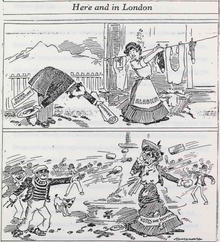
This is a timeline of women's suffrage in Alaska. Non-native women in Alaska had the right to vote in school board elections starting in 1904. In 1913, the first Territorial Legislature passed the Shoup Suffrage Bill which gave non-native women the right to vote in all elections. Alaska Native women had a longer road fighting for their right to vote. First, they had to be declared citizens of the United States, but even after that happened in 1924, additional barriers were put in place. These included literacy tests and segregation. The Voting Rights Act of 1965 helped remove many barriers that Alaska Natives faced in exercising their right to vote.
20th century

1900s
1904
- Alaska women are given the right to vote in school board elections.
1910s
1912
- Representative Frank W. Mondell adds an amendment to a bill making Alaska an American Territory that would allow the territorial legislature to legislate equal suffrage for women.
- Cornelia Templeton Hatcher drafts a petition to the territorial legislature of Alaska for women's suffrage.
- Nellie Cashman is the first woman to vote in Alaska.
- The Alaska Native Brotherhood (ANB) is formed.
1913
- The Shoup Woman Suffrage bill is passed in 1913, giving women the right to vote in Alaska if they are considered United States citizens.
- March 21: The Shoup Suffrage bill is signed into law.
1915
- The Alaska Native Sisterhood (ANS) is formed.
- Alaska Natives are allowed to vote if they give up "tribal customs and traditions."
1920s
1924
- The Indian Citizenship Act is passed.
1925
- Alaska passes a literacy test to suppress the vote of Alaska Natives.
1940s
1943
- Chinese Americans are able to vote after the passage of the Magnuson Act.
1945
- Alaska anti-discrimination law ends segregation of Native Alaskans.
1950s
1950
- The Anchorage League of Women Voters (LWV) is formed.
1959
- The new state of Alaska has a more lenient literacy test.
1960s
1965
- The Voting Rights Act (VRA) is passed which helps remove many voting barriers to Native Alaskans.
1967
- The statewide LWV is formed.
1970s
1970
- Literacy tests are ended in Alaska.
1975
- The VRA is modified to provide voting information in Native languages.
See also
- List of Alaska suffragists
- Women's suffrage in Alaska
- Women's suffrage in states of the United States
- Women's suffrage in the United States
References
- Harper 1922, p. 714.
- Christen 2019, p. 90.
- ^ Harper 1922, p. 713.
- Lapka, Alyssa (13 March 2019). "The Life of Cornelia Templeton Jewett Hatcher". Alaska Historical Society. Retrieved 2020-11-09.
- Lange, Jeva (2020-08-18). "5 important suffragists you didn't learn about in school". The Week. Retrieved 2020-11-08.
- ^ Sostaric, Katarina (2015-10-12). "Alaska Native Sisterhood celebrates 100th anniversary in Wrangell". KTOO. Retrieved 2020-11-08.
- "Shoup Woman Suffrage Bill: House Bill No. 2, March 21, 1913". Alaska's Digital Archives. Retrieved 8 November 2020.
- ^ "Alaska and the 19th Amendment". U.S. National Park Service. Retrieved 2020-11-08.
- "First Territorial Legislature of Alaska". U.S. National Park Service. Retrieved 2020-11-09.
- "History and Culture: Citizenship Act - 1924". Northern Plains Reservation Aid. Retrieved 2020-11-09.
- Cole 1992, p. 433.
- ^ Carney, Amy. "Alaska's Suffrage Star: Home". Alaska Libraries, Archives, Museums. Retrieved 2020-11-12.
- Cole 1992, p. 449.
- ^ Christen 2019, p. 98.
- Tucker, Landreth & Lynch 2017, p. 336.
Sources
- Christen, Morgan (2019). "Alaska Native Women's Long Road to Suffrage" (PDF). Western Legal History. 30 (1): 89–100.
- Cole, Terrence M. (November 1992). "Jim Crow in Alaska: The Passage of the Alaska Equal Rights Act". Western Historical Quarterly. 23 (4): 429–449. doi:10.2307/970301. JSTOR 970301. S2CID 163528642 – via JSTOR.
- Harper, Ida Husted (1922). The History of Woman Suffrage. New York: J.J. Little & Ives Company.
- Tucker, James Thomas; Landreth, Natalie A.; Lynch, Erin Dougherty (2017). "'Why Should I Go Vote Without Understanding What I Am Going to Vote For?' The Impact of First Generation Voting Barriers on Alaska Natives". Michigan Journal of Race and Law. 22 (2): 327–382. doi:10.36643/mjrl.22.2.why. S2CID 149117802.